2003 CHEVROLET VENTURE seats
[x] Cancel search: seatsPage 1 of 486

Seats and Restraint Systems........................... 1-1
Front Seats
............................................... 1-3
Rear Seats
............................................... 1-7
Safety Belts
.............................................1-30
Child Restraints
.......................................1-55
Air Bag Systems
......................................1-93
Restraint System Check
..........................1-103
Features and Controls..................................... 2-1
Keys
........................................................ 2-3
Doors and Locks
....................................... 2-9
Windows
.................................................2-24
Theft-Deterrent Systems
............................2-27
Starting and Operating Your Vehicle
...........2-31
Mirrors
....................................................2-44
OnStar
žSystem
......................................2-45
HomeLinkžTransmitter
.............................2-47
Storage Areas
.........................................2-51
Vehicle Personalization
.............................2-61
Instrument Panel............................................. 3-1
Instrument Panel Overview
.......................... 3-4
Climate Controls
......................................3-25
Warning Lights, Gages and Indicators
.........3-35
Message Center
.......................................3-50
Driver Information Center (DIC)
..................3-58
Audio System(s)
.......................................3-61Driving Your Vehicle....................................... 4-1
Your Driving, the Road, and Your Vehicle
..... 4-2
Towing
...................................................4-32
Service and Appearance Care.......................... 5-1
Service
..................................................... 5-3
Fuel
......................................................... 5-4
Checking Things Under the Hood
...............5-10
All-Wheel Drive
........................................5-50
Bulb Replacement
....................................5-52
Windshield Wiper Blade Replacement
.........5-58
Tires
......................................................5-60
Appearance Care
.....................................5-87
Vehicle Identi®cation
.................................5-95
Electrical System
......................................5-96
Capacities and Speci®cations
...................5-103
Normal Maintenance Replacement Parts
....5-104
Maintenance Schedule..................................... 6-1
Maintenance Schedule
................................ 6-2
Customer Assistance Information.................... 7-1
Customer Assistance Information
.................. 7-2
Reporting Safety Defects
............................ 7-9
Index.................................................................1
2003 Chevrolet Venture Owner ManualM
Page 4 of 486
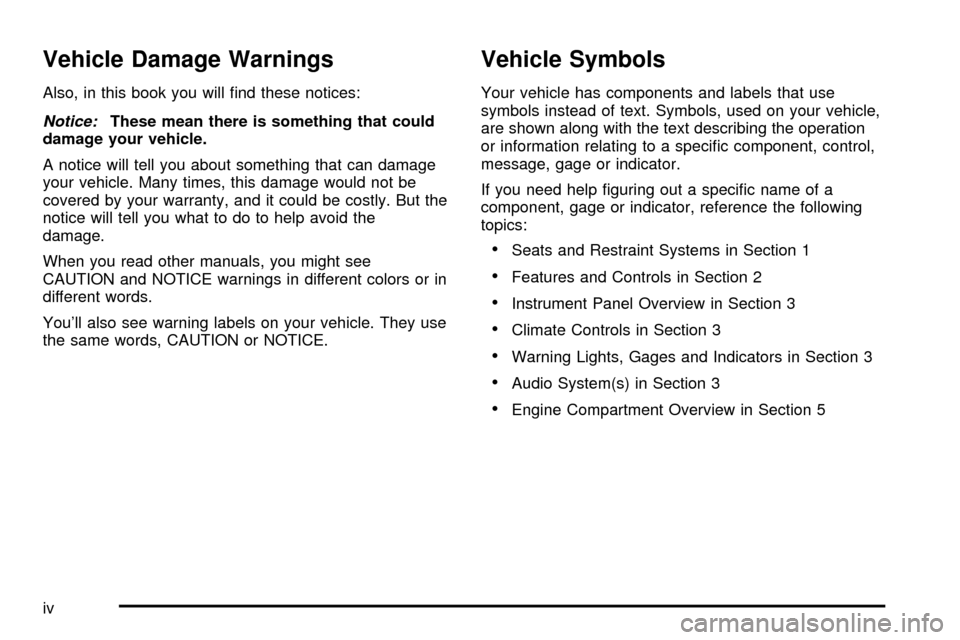
Vehicle Damage Warnings
Also, in this book you will ®nd these notices:
Notice:These mean there is something that could
damage your vehicle.
A notice will tell you about something that can damage
your vehicle. Many times, this damage would not be
covered by your warranty, and it could be costly. But the
notice will tell you what to do to help avoid the
damage.
When you read other manuals, you might see
CAUTION and NOTICE warnings in different colors or in
different words.
You'll also see warning labels on your vehicle. They use
the same words, CAUTION or NOTICE.
Vehicle Symbols
Your vehicle has components and labels that use
symbols instead of text. Symbols, used on your vehicle,
are shown along with the text describing the operation
or information relating to a speci®c component, control,
message, gage or indicator.
If you need help ®guring out a speci®c name of a
component, gage or indicator, reference the following
topics:
·Seats and Restraint Systems in Section 1
·Features and Controls in Section 2
·Instrument Panel Overview in Section 3
·Climate Controls in Section 3
·Warning Lights, Gages and Indicators in Section 3
·Audio System(s) in Section 3
·Engine Compartment Overview in Section 5
iv
Page 7 of 486
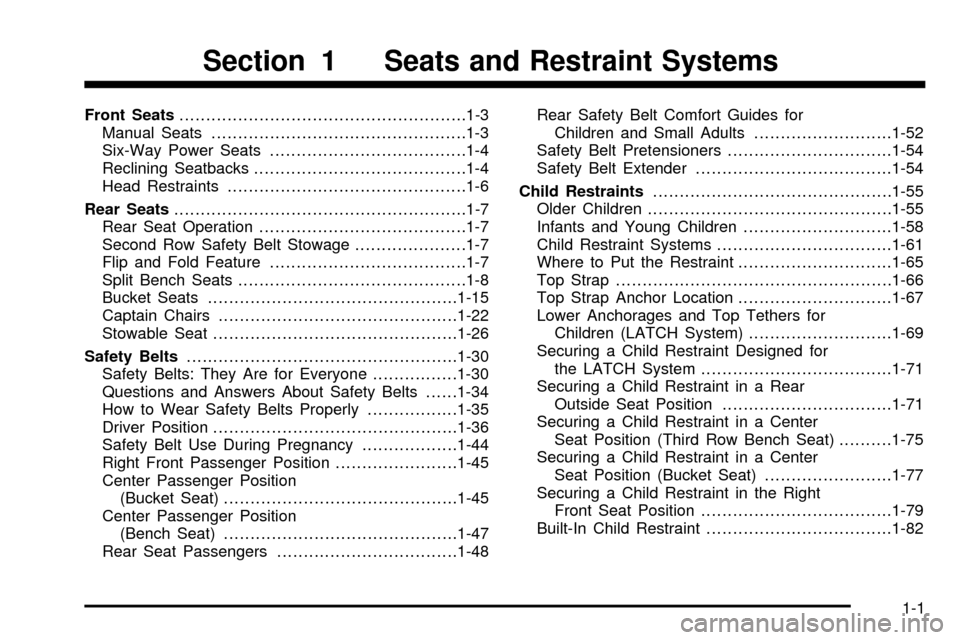
Front Seats......................................................1-3
Manual Seats................................................1-3
Six-Way Power Seats.....................................1-4
Reclining Seatbacks........................................1-4
Head Restraints.............................................1-6
Rear Seats.......................................................1-7
Rear Seat Operation.......................................1-7
Second Row Safety Belt Stowage.....................1-7
Flip and Fold Feature.....................................1-7
Split Bench Seats...........................................1-8
Bucket Seats...............................................1-15
Captain Chairs.............................................1-22
Stowable Seat..............................................1-26
Safety Belts...................................................1-30
Safety Belts: They Are for Everyone................1-30
Questions and Answers About Safety Belts......1-34
How to Wear Safety Belts Properly.................1-35
Driver Position..............................................1-36
Safety Belt Use During Pregnancy..................1-44
Right Front Passenger Position.......................1-45
Center Passenger Position
(Bucket Seat)............................................1-45
Center Passenger Position
(Bench Seat)............................................1-47
Rear Seat Passengers..................................1-48Rear Safety Belt Comfort Guides for
Children and Small Adults..........................1-52
Safety Belt Pretensioners...............................1-54
Safety Belt Extender.....................................1-54
Child Restraints.............................................1-55
Older Children..............................................1-55
Infants and Young Children............................1-58
Child Restraint Systems.................................1-61
Where to Put the Restraint.............................1-65
Top Strap....................................................1-66
Top Strap Anchor Location.............................1-67
Lower Anchorages and Top Tethers for
Children (LATCH System)...........................1-69
Securing a Child Restraint Designed for
the LATCH System....................................1-71
Securing a Child Restraint in a Rear
Outside Seat Position................................1-71
Securing a Child Restraint in a Center
Seat Position (Third Row Bench Seat)..........1-75
Securing a Child Restraint in a Center
Seat Position (Bucket Seat)........................1-77
Securing a Child Restraint in the Right
Front Seat Position....................................1-79
Built-In Child Restraint...................................1-82
Section 1 Seats and Restraint Systems
1-1
Page 8 of 486
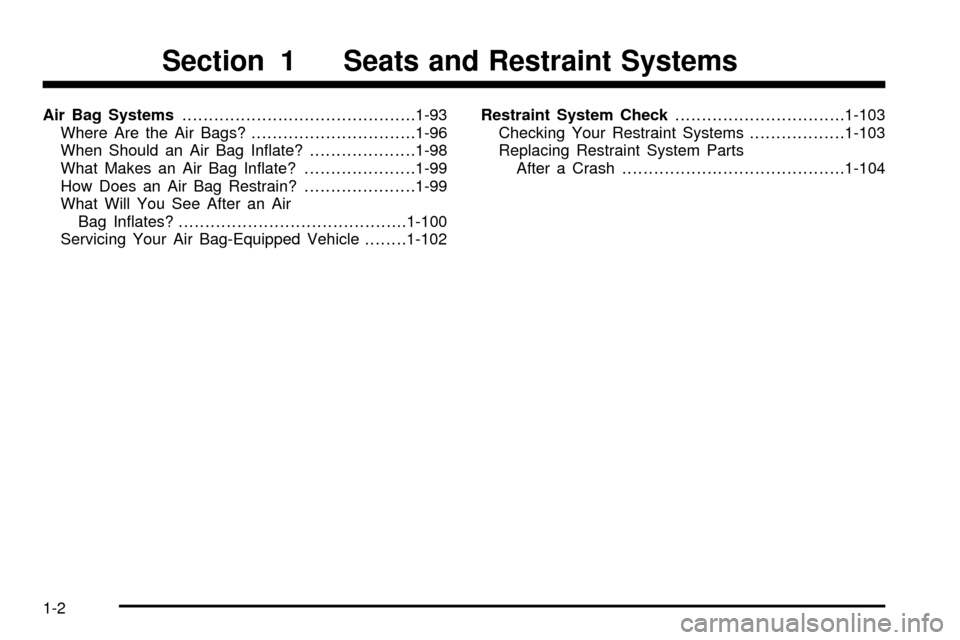
Air Bag Systems............................................1-93
Where Are the Air Bags?...............................1-96
When Should an Air Bag In¯ate?....................1-98
What Makes an Air Bag In¯ate?.....................1-99
How Does an Air Bag Restrain?.....................1-99
What Will You See After an Air
Bag In¯ates?...........................................1-100
Servicing Your Air Bag-Equipped Vehicle........1-102Restraint System Check................................1-103
Checking Your Restraint Systems..................1-103
Replacing Restraint System Parts
After a Crash..........................................1-104
Section 1 Seats and Restraint Systems
1-2
Page 9 of 486

Front Seats
Manual Seats
Use the lever located on
the front of the seat to
adjust the seat forward or
rearward. Pull up the
lever to unlock the seat.
Slide the seat to where
you want it and release
the lever.
{CAUTION:
You can lose control of the vehicle if you try to
adjust a manual driver's seat while the vehicle
is moving. The sudden movement could startle
and confuse you, or make you push a pedal
when you don't want to. Adjust the driver's
seat only when the vehicle is not moving.
To make sure the seat is locked into place, try to move
the seat back and forth with your body.
1-3
Page 10 of 486
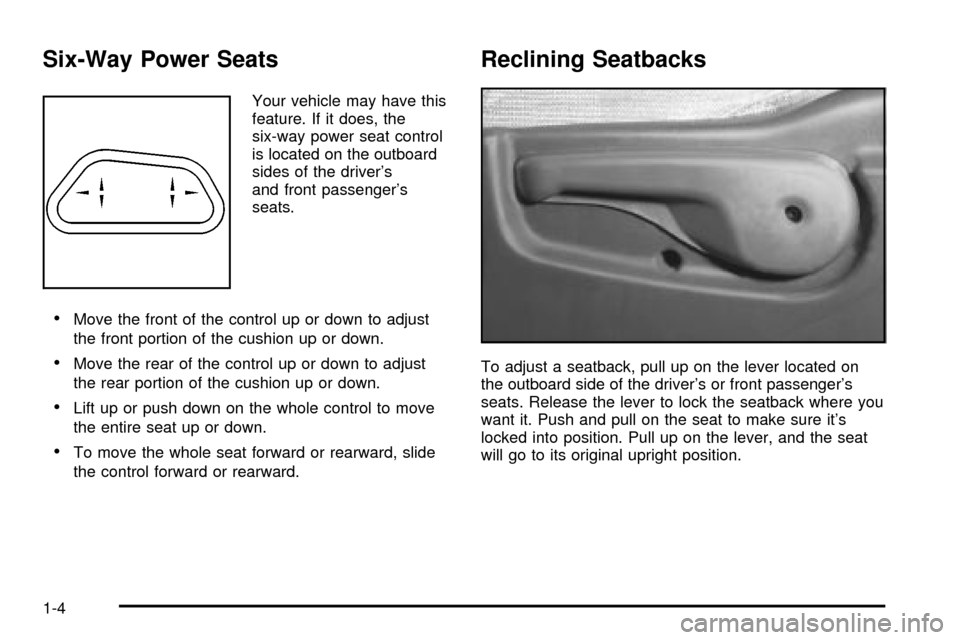
Six-Way Power Seats
Your vehicle may have this
feature. If it does, the
six-way power seat control
is located on the outboard
sides of the driver's
and front passenger's
seats.
·Move the front of the control up or down to adjust
the front portion of the cushion up or down.
·Move the rear of the control up or down to adjust
the rear portion of the cushion up or down.
·Lift up or push down on the whole control to move
the entire seat up or down.
·To move the whole seat forward or rearward, slide
the control forward or rearward.
Reclining Seatbacks
To adjust a seatback, pull up on the lever located on
the outboard side of the driver's or front passenger's
seats. Release the lever to lock the seatback where you
want it. Push and pull on the seat to make sure it's
locked into position. Pull up on the lever, and the seat
will go to its original upright position.
1-4
Page 13 of 486
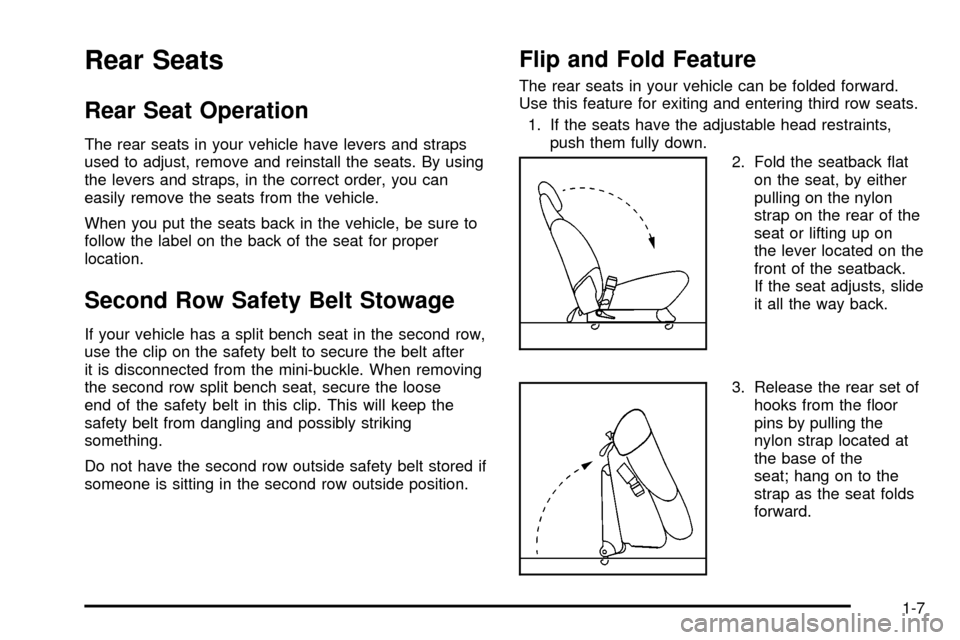
Rear Seats
Rear Seat Operation
The rear seats in your vehicle have levers and straps
used to adjust, remove and reinstall the seats. By using
the levers and straps, in the correct order, you can
easily remove the seats from the vehicle.
When you put the seats back in the vehicle, be sure to
follow the label on the back of the seat for proper
location.
Second Row Safety Belt Stowage
If your vehicle has a split bench seat in the second row,
use the clip on the safety belt to secure the belt after
it is disconnected from the mini-buckle. When removing
the second row split bench seat, secure the loose
end of the safety belt in this clip. This will keep the
safety belt from dangling and possibly striking
something.
Do not have the second row outside safety belt stored if
someone is sitting in the second row outside position.
Flip and Fold Feature
The rear seats in your vehicle can be folded forward.
Use this feature for exiting and entering third row seats.
1. If the seats have the adjustable head restraints,
push them fully down.
2. Fold the seatback ¯at
on the seat, by either
pulling on the nylon
strap on the rear of the
seat or lifting up on
the lever located on the
front of the seatback.
If the seat adjusts, slide
it all the way back.
3. Release the rear set of
hooks from the ¯oor
pins by pulling the
nylon strap located at
the base of the
seat; hang on to the
strap as the seat folds
forward.
1-7
Page 14 of 486

To return the seat(s) to the normal position, do the
following:
1. Push the seat back and ®rmly push the rear hooks
onto the rear ¯oor pins by pushing down on the
rear of the seat.
2. Try to raise the seat to check that it is locked down.
3. Lift the seatback recliner lever or pull the nylon
strap on the back of the seat and raise the
seatback until it locks upright.
4. Push and pull on the seatback to check that it is
locked.Split Bench Seats
If you have the split bench seat (50/50 or 40/60), the
seatbacks can be folded forward or reclined individually
and the seats can be removed individually. The
second row (40/60) sections can also be adjusted
forward or rearward individually.
The second row (40/60) split bench may be equipped
with a built-in child restraint. See
Built-In Child Restraint
on page 1-82.
1-8